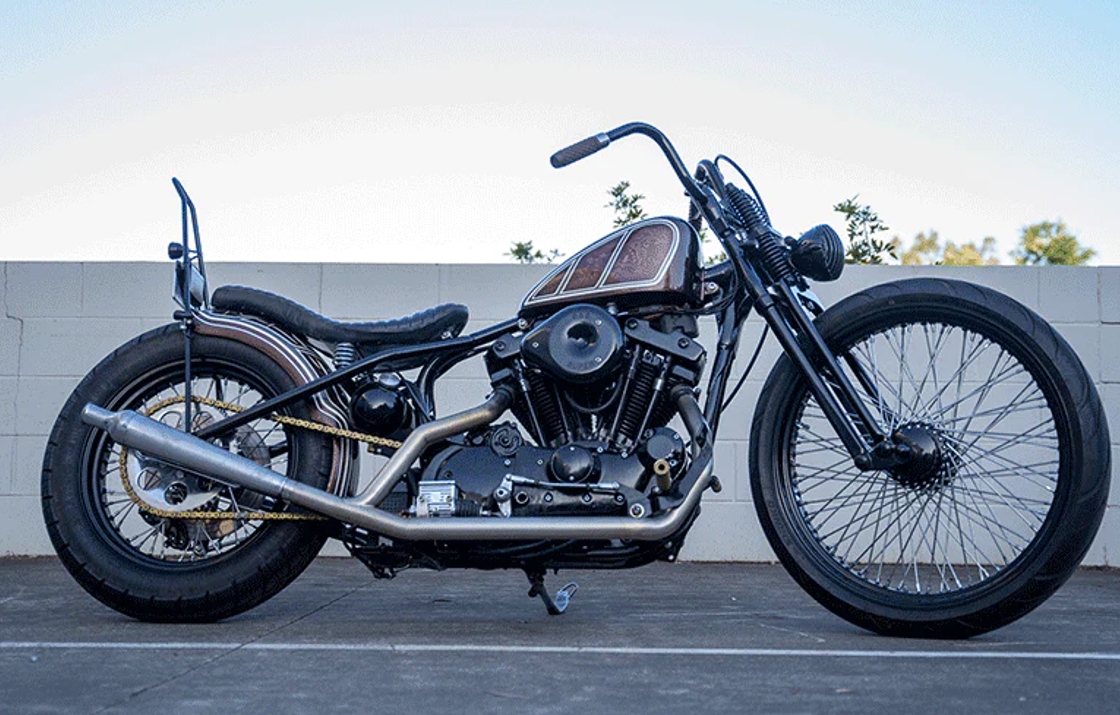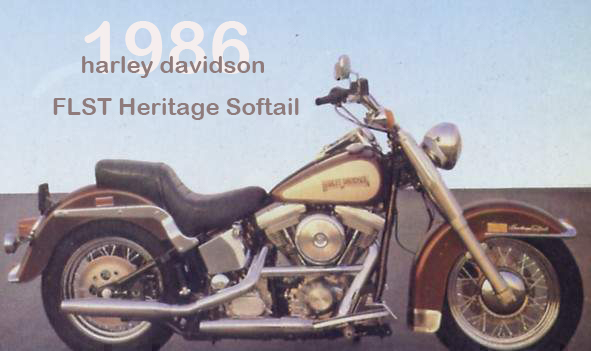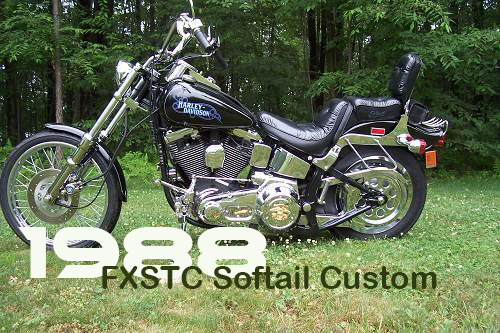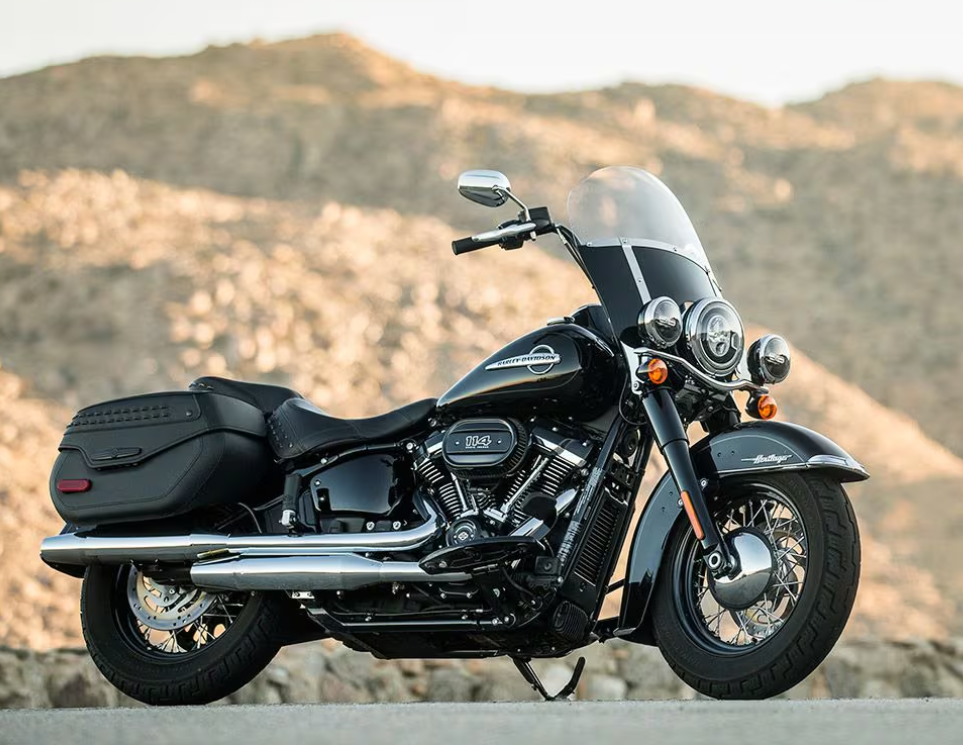Introduction
The Harley-Davidson Softail Series is a true icon of American motorcycle engineering. It perfectly blends retro style with modern technology. Since its launch in 1984, the Softail line has won over riders worldwide with its signature hidden rear suspension, classic looks, and smooth ride—becoming a symbol of American biking culture.
This article dives into the Softail’s history, key innovations, and its role in Harley’s legacy. We’ll explore how it evolved from a groundbreaking design into a cultural phenomenon.
The Origins of the Softail (Pre-1984)

HarleyDavidson-Hardtail
Before Softail bikes came out, most Harley cruisers used simple “hardtail” frames with no real rear suspension – just the seat springs to soften bumps. This bare-bones setup gave bikes like the 40s-60s Panhead and Shovelhead their tough, clean look, but made long rides painfully rough.
Then in the 70s, Japanese bikes from Honda and Kawasaki started winning over American riders with their smoother suspensions and reliable engines. Harley knew they had to make rides more comfortable without losing that classic Harley style.
The solution came from custom bike builder Bill Davis. Around 1980, he invented a clever hidden rear suspension that kept the old-school hardtail look but worked way better:
- Added 2 inches of suspension travel
- Soaked up 70% more road bumps
Harley bought his design in 1982 and turned it into the game-changing Softail system we know today.
First-Gen Softail (1984–1999): Where Innovation Met Classic Design
In 1984, Harley-Davidson changed the game with the FXST Softail – the first bike in their now-famous Softail line. This wasn’t just another motorcycle. It had a secret weapon: Bill Davis’ hidden suspension system that gave riders the best of both worlds.
The FXST kept all the clean, classic lines that made hardtail Harleys so iconic. But here’s the kicker – it actually rode comfortably. No more feeling every bump in the road. The hidden suspension soaked up the rough stuff while keeping that tough, no-nonsense look Harley fans loved.
For the first time, riders didn’t have to choose between looking cool and being comfortable on long rides. The Softail did both, and that’s why it became an instant classic. This was Harley-Davidson doing what they do best – taking traditional American motorcycle style and making it work even better.
Major Models:
- FXST Softail (1984) : Equipped with the Evolution V2 engine (1340cc), it became the pioneering model of the Softail series, laying the foundation for the lineup.
- FLST Heritage Softail (1986) : It features retro-style fenders, whitewall tires, and a large front fairing, paying homage to Harley-Davidson’s classic 1950s models.
- FXSTC Softail Custom (1998) : It adopts a more aggressive styling with a lowered seat and a wider rear tire, targeting the younger generation of riders.

FXST Softail (1984)

FLST Heritage Softail (1986)

FXSTC Softail Custom (1998)
This generation of Softail models successfully appealed to riders who sought both classic styling and modern comfort, solidifying its position as a core Harley-Davidson product line and a key growth driver for the brand.
The Twin Cam Era (1999–2017): Power Upgrades & Bold New Styles
In 1999, Harley-Davidson introduced the Twin Cam 88 engine (later upgraded to 96B and 103B), marking a significant evolution for the Softail series. The new powertrain delivered enhanced performance and smoother operation, while the model lineup expanded to offer greater variety.

<em><em>HarleyDavidson-FLSTF Fat Boy</em></em>
Representative models:
- FLSTF Fat Boy (launched in 1990, received major upgrades in the Twin Cam era): Gaining fame through Terminator 2, this iconic model features distinctive solid-disc wheels and an aggressive wide-tire stance.
- FLSTN Softail Deluxe (2005): With its gleaming chrome accents and streamlined silhouette, this model masterfully recreates the luxurious cruising aesthetic of the 1940s-50s golden era.
- FXSTSSE Softail Springer Special Edition (2008): his limited-edition model captivated younger riders with its sinister dark theme, featuring a slammed profile and menacing blacked-out finishes.
- FXS Blackline (2011): Embracing radical minimalism, this dark-themed cruiser elevated the blackout aesthetic while achieving remarkable weight reduction.
During this phase, the Softail lineup not only preserved its iconic heritage but also expanded through specialized variants to cater to personalized demands, significantly strengthening its market dominance.
Milwaukee-Eight Era (2018–Present): Modern Muscle
In 2018, Harley-Davidson revolutionized its Softail lineup with the all-new Milwaukee-Eight engine (107/114 cubic-inch variants), marking the most comprehensive upgrade in the series’ history. The redesigned chassis achieved significant weight reduction while enhancing structural rigidity, paired with optimized suspension systems – all while meticulously preserving the iconic Softail silhouette that defines the lineage.
The new generation of Softail models:
- Softail Standard (2018); Back to basics with a clean, simple design perfect for beginner riders.
- Fat Boy 114 (2018)Delivers more power and a modern look while keeping its signature wide-tire style.
- Heritage Classic 114 (2018): Blends vintage styling with modern technology, featuring a detachable windshield and hard saddlebags.
- Softail Slim (2018):Features a lowered seat and stripped-down design inspired by post-WWII bobber style.
This generation of Softail models delivers significant improvements in performance, handling and comfort while further strengthening its position as the definitive classic cruiser motorcycle.

Fat Boy 114(2018)

Softail Slim(2018)

Heritage Classic 114(2018)
The Softail’s Cultural Impact
The Softail series stands not only as Harley-Davidson’s engineering masterpiece, but also as an enduring symbol of American motorcycle culture. Its iconic design has influenced countless custom bikes and made frequent appearances in pop culture – most notably the Fat Boy in Terminator 2.
More significantly, Softail’s success demonstrates Harley-Davidson’s unique ability to balance heritage with innovation. The series continues to satisfy traditional riders’ demand for classic styling while attracting new generations of enthusiasts through constant technological evolution.
What’s Next
Harley-Davidson is embracing electrification while keeping its iconic gas-powered Softail models (confirmed in production until at least 2030). Recent patents show a hybrid prototype that maintains the classic Softail silhouette has already undergone wind tunnel testing. The innovative design cleverly hides lithium batteries in the hardtail-style frame while keeping the traditional Milwaukee-Eight engine as the main power source, supplemented by an electric motor integrated into the transmission.
The innovative design features:
- a lithium battery pack discreetly housed within the hardtail-style frame
- the signature Milwaukee-Eight engine remaining as the primary power source
- an electric motor integrated into the transmission case providing supplemental boost.
Conclusion
Since its debut in 1984, the Harley-Davidson Softail series has evolved over nearly four decades while staying true to its core philosophy: “classic style meets modern performance.” From the early FXST models and the iconic Fat Boy of the Twin Cam era to today’s Milwaukee-Eight-powered machines, the Softail lineup has continually refined itself, cementing its status as an American motorcycle legend.
More than just a bike, the Softail represents a cultural icon—embodying the spirit of freedom, adventure, and uncompromising attitude. For riders who crave authentic American cruising, the Softail remains one of the purest and most desirable choices. Its story is far from over, and with every roar of its engine, it continues to write new chapters in Harley-Davidson’s storied legacy.

